Super Mario Bros. 2 (NES)
| Super Mario Bros. 2 |
|---|
|
Also known as: Super Mario USA (JP)
|
As most Nintendo fans already know by this point, the game released as Super Mario Bros. 2 outside of Japan was not the same Super Mario Bros. 2 that Japan had gotten in 1986. Apparently, Nintendo thought the Japanese Mario 2 was too similar to the original Super Mario Bros. (being essentially a new set of levels for the first game) and much more difficult than its predecessor, so they took another game they made and modified it to serve as the Mario sequel for the west (saving themselves the trouble of having to renumber Super Mario Bros. 3 when it came time to localize it).
Fortunately, Mario 2 was a smash hit, and many characters introduced in this game (Birdo, Shy Guys, Ninjis) were gradually incorporated into the Mario universe.
Contents
Sub-Pages
| Prototype Info |
Unused Graphics
Doki Doki Panic Leftovers
Found among the graphics used in the ending scenes.
A magic lamp. This became the Potion, and has the same effect (creates a door to Subspace).
This heart was the equivalent to the Mushrooms found in Subspace. Interestingly, the instruction manual mentions that Subspace has hearts in certain places, despite the Mushroom having been mentioned on the previous page.
A lock and a metal platform. These were used in the ending of Doki Doki Panic (it's where Wart kept the two children he kidnapped in the prologue), and don't have any equivalent in Super Mario Bros. 2.
The original Albatoss sprite, no longer used as SMB2 uses a new and more elaborate set of sprites for it. The first half of the first sprite is duplicated 8 times in the graphical data for the playable characters.
Prototype Leftovers
Yes, money. This was used in the ending of the prototype where, instead of a display showing how many times each character was used, you received "prize money" based on the number of times you died.
Miscellaneous Graphics
Hidden in the tileset for the desert stages is a little smiley face that isn't used anywhere in the prototype, final, or Doki Doki Panic. It appears to just be a placeholder.
Eighth Animation Frame
The animated tiles, such as the POW Blocks and Cherries, actually have eight frames of animation. However, due to a bug, only the first seven frames are actually displayed. To fix this and cycle through all eight frames, set $FAF5 ($1FB05 in the ROM) to $28, or use Game Genie code AXNYSZTX. Note that the graphics for the top of the waterfall, the POW block, the slower quicksand, and Albatoss are unique to this missing frame.
| Used | Full |
|---|---|
| Used | Full |
|---|---|
The Albatoss and POW Block have noticeably smoother animations with the missing frames added.
Book Border Tiles
The between-level and pause screens in Doki Doki Panic are two screens wide and resemble an open book, keeping in line with the game's story. In Super Mario Bros. 2, these were shrunk to one screen and the book theme was (mostly) removed; however, the extra tiles can still be found in the CHR data.
Unused Death Sound
The game is programmed to play a DPCM sample when the player dies (a recording of the sound heard in Yume Koujou: Doki Doki Panic, in fact). However, due to the fact that the sound engine silences DPCM samples on music track changes, the sound does not actually play.
Full Subspace Music
The music track used in Subspace is actually a bit longer than what you can normally hear. Under normal circumstances, the game boots you out of Subspace after about seven seconds, which prevents you from hearing the full 14-second loop. The easiest way to hear it in-game is to pick up a Starman, enter Subspace, and then exit just before the invincibility wears off; if done correctly, the Subspace music will continue to play until the next track change.
To hear the full song at the title screen, use Game Genie code KEOOXXSE.
The full track also plays in the 3.0.0 update of Super Mario Maker 2, upon collecting the SMB2 Mushroom and hitting a P Switch.
Unused Text
The string "ZELDA" is present at ROM address 0x1FFFB. It appears that Nintendo copied the PRG footer/vector table from The Legend of Zelda (another FDS-to-NES conversion) and simply forgot to change the title.
Revisional Differences
Fryguy Glitch
| Revision 0 | Revision 1 |
|---|---|
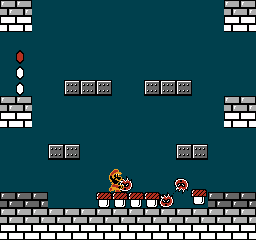 |
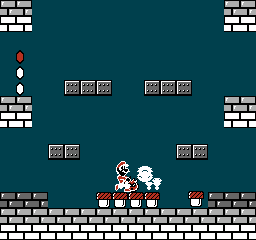 |
Normally, hitting a mini-Fryguy with a Mushroom Block will cause it to disappear in a puff of smoke. In the original release, however, if you manage to hit one while your character is shrinking, it will flip upside-down and fall off the screen instead.
This somehow confuses the game into thinking there are mini-Fryguys left even after the rest are extinguished, and hence the exit will never appear. This game-breaking bug was fixed in Revision 1.
Bonus Chance
| US Revision 0 (NTSC) | US Revision 0 (PAL) |
|---|---|
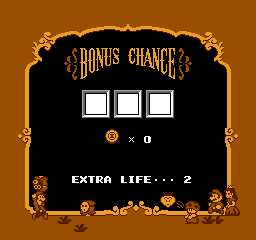 |
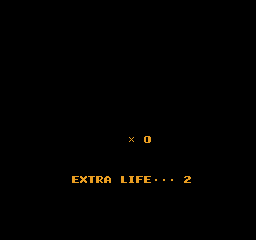 |
Revision 1 adds an extra NMI wait before drawing the Bonus Chance screen layout. This was done to resolve an issue where the screen fails to render properly on PAL consoles (essentially, an NMI occurs immediately after the pointer to the screen layout data is set, which causes it to be erased before the game can actually do anything with it). Although the US Revision 1 was not actually released in PAL territories, it was used as a base for the PAL Revision 0.
Regional Differences
| Regional Differences It takes a lot to convert a promotional item into a wildly popular game. |
| US/Europe | Japan |
|---|---|
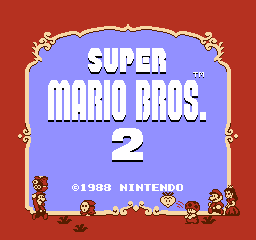 |
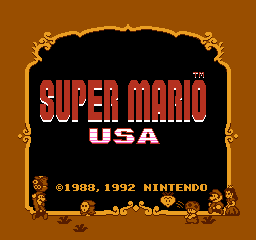 |
Nintendo made the somewhat odd decision to release Super Mario Bros. 2 in Japan more than four years after the US release, under the title Super Mario USA (due to the Japanese Super Mario Bros. 2 being a completely different game, released later in the US as The Lost Levels as part of Super Mario All-Stars). Aside from the modified title screen, it is identical to the US Revision 1 version.
Virtual Console Re-release Changes and Unused Content
| To do: Do more research on this, and see if there's anything else the 3DS VC version changes/leaves unused. |
Unused Text
The Virtual Console's config.ini contains unused text related to a variety of things.
| Line | Text | Notes |
|---|---|---|
| 76 | NetDelay = 3 ;Multi Play - Network Delay Frame | Possibly some kind of lag compensation for wireless play? It's unusual to see this option here as Super Mario Bros. 3 is the only VC game to allow wireless multiplayer, as well the fact that SMB2 is a single player game. |
Build Time
The file buildtime.txt contains the build time string "4月 12 2013 13時14分15秒" which translates to "April 12th, 2013 1:14:15 PM".
- Pages missing developer references
- Games developed by Nintendo
- Pages missing publisher references
- Games published by Nintendo
- Pages missing date references
- Games with unused graphics
- Games with unused music
- Games with unused sounds
- Games with unused text
- Games with regional differences
- Games with revisional differences
- To do
- Mario series
Cleanup > Pages missing date references
Cleanup > Pages missing developer references
Cleanup > Pages missing publisher references
Cleanup > To do
Games > Games by content > Games with regional differences
Games > Games by content > Games with revisional differences
Games > Games by content > Games with unused graphics
Games > Games by content > Games with unused music
Games > Games by content > Games with unused sounds
Games > Games by content > Games with unused text
Games > Games by developer > Games developed by Nintendo
Games > Games by publisher > Games published by Nintendo
Games > Games by series > Mario series


